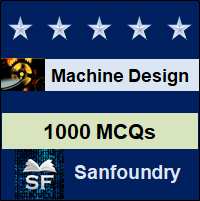This set of Machine Design Multiple Choice Questions & Answers (MCQs) focuses on “Band Brakes & Disk Brakes”.
1. In both simple band brake and differential band brake, at least one end of the band passes through fulcrum.
a) Both the ends
b) Neither end
c) One end
d) None of the listed
View Answer
Explanation: In differential, neither end of the brake passes through fulcrum.
2. Is it possible to prevent back rotation of drum?
a) Yes by using back stop brake
b) No
c) Depends on the angular velocity
d) Only in some specific cases
View Answer
Explanation: Back stop brake can be used to prevent rotation of drum.
3. A self-locking differential brake and back stop brakes is same thing.
a) True
b) False
View Answer
Explanation: Back stop brake is other name of self locking differential brake.
4. Band brake has complex construction with large number of parts.
a) Yes
b) It has simple construction
c) It has simple constructions but large number of parts
d) It has complicated construction but small number of parts
View Answer
Explanation: Band brake has simple construction with small number of parts.
5. Band brakes require _____ maintenance.
a) Little
b) Zero
c) Much
d) None of the listed
View Answer
Explanation: There is relatively less maintenance required as there are small number of parts and hence chances of brake going out of order is less.
6. The wear of band brake is even.
a) True
b) False
View Answer
Explanation: There is uneven wear from one side to other side of the friction lining.
7. Calculate the braking torque if tension in the two sides is 3500N and 1980N with radius of drum being 160mm.
a) None of the mentioned
b) 243.20N-m
c) 223.4N-m
d) 278.6N-m
View Answer
Explanation: Braking torque=(3500-1980)x160/1000.
8. Disk brakes have low torque transmitting capacity in high volumes.
a) True
b) False
View Answer
Explanation: They have high torque transmitting capacity in low volumes.
9. In drum brakes, as the temperature increases coefficient of friction ______
a) increases
b) decreases
c) remains same
d) Can’t be determined
View Answer
Explanation: Coeffecient of friction varies inversely with the temperature.
10. Loss of torque transmitting capacity at high temperatures is called
a) Fading
b) Rolling
c) Drifting
d) Planking
View Answer
Explanation: Terminology.
11. Disk brakes largely suffer from the problem of self-locking.
a) Yes
b) No
c) Self-locking but it depends on radius of the wheel rotating
d) Material dependent
View Answer
Explanation: There is no problem of self-locking in disk brakes.
12. Disk brakes can be used for opposite rotation of disk also.
a) No they are effective for one direction of motion only
b) They can be used
c) Poor efficiency in opposite direction
d) None of the listed
View Answer
Explanation: Disk brakes are equally effective for both direction of motion.
13. The disk brake torque is linearly proportional to the actuating force.
a) Yes
b) No, it is proportional to its square
c) Proportional to its cube
d) Independent of force
View Answer
Explanation: M=μPr.
Sanfoundry Global Education & Learning Series – Machine Design.
To practice all areas of Machine Design, here is complete set of 1000+ Multiple Choice Questions and Answers.
If you find a mistake in question / option / answer, kindly take a screenshot and email to [email protected]
- Check Mechanical Engineering Books
- Practice Mechanical Engineering MCQs
- Apply for Mechanical Engineering Internship
- Practice Metallurgical Engineering MCQs
- Check Machine Design Books

